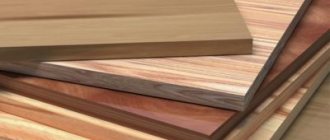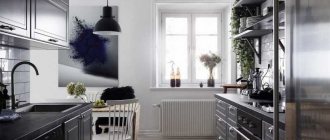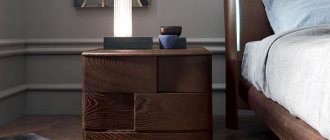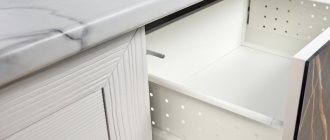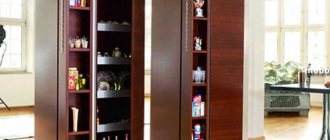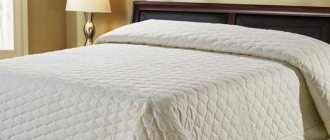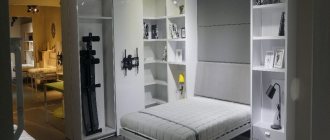Tools and materials
To make this piece of furniture we will need the following materials:
- 4 laminated pine panels 45.5x70 centimeters, which will be used as side, bottom and top panels;
- 8 pine boards from which the frame will be made, dimensions – 6.9x39.9 centimeters;
- 4 pine panels with laminated coating for arranging drawers, dimensions - 17x43.5 centimeters;
- screws 4 and 1.6 centimeters;
- wood glue;
- dowel with a diameter of 2 and a length of 1.8 centimeters;
- sponge;
- acrylic sealant;
- stain;
- wood filler.
By following the link, you will learn how to make a minibar with your own hands. This article contains instructions for making your own shoe rack from MDF. An excellent solution for a summer house would be a wooden table on a metal frame.
The tools we will need are:
- miter saw;
- electric drill;
- roulette;
- pencil;
- Sander;
- sandpaper.
Return to content
Assembly Tips and Tricks
It is recommended to assemble the cabinet on a flat, hard surface. After connecting any 4 parts into a solid structure, it is recommended to check its coal content. The fastening of fittings and decorative finishing begins after errors have been eliminated and eliminated. You need to be very careful during manufacturing.
Sometimes, in addition to standard parts, chests of drawers also have additional parts.
It is necessary to immediately remove glue drips if any have formed. When sanding edges, do not scratch the laminated coating, as... It is impossible to seal them later even by re-coating them with varnish. When installing drawers in place, check for smooth movement. If something interferes, do not use force, first find out the cause of the jamming and eliminate it.
Having the necessary materials, tools, and most importantly the desire at hand, even an inexperienced person can make a bedside table with their own hands. This option of assembling furniture for your home will help not only save money, but also get a unique piece of furniture.
How to assemble a bedside table with drawers
When purchasing cabinet furniture for home and garden in a store, many are guided by the principle of simplicity. I chose something more or less suitable in size, paid, and received it delivered to my home. All that remains is to assemble. It's good that the kit always includes assembly instructions. However, for many this becomes a problem. Without experience and appropriate understanding, simple assembly turns into torture.
To simplify the task for such craftsmen, we will analyze the assembly process using the example of a bedside table with drawers. Knowing how to assemble a nightstand with drawers will help you handle other items as well. After all, all other furniture is assembled in the same way.
The principle of assembling the box
A box without a front element, which is assembled first, consists of a bottom with three walls screwed to it. In factory cabinets, the bottom is made of hardboard (hard fiberboard). This material is chosen not because it is better, but because it is cheaper in mass production.
1. When working independently at home, it is much more convenient to use the same material for making the bottoms as for the walls - 16 mm thick laminated chipboard. One sheet, the area of which is about 4 m², is enough for the entire bedside table.
Fastening the side walls of the box with confirmations
Fastening the facade to an eccentric screed
2. Such thick sheet material is used to ensure that the connections of perpendicularly located elements, which are made on confirmations, are as strong as possible.
3. Confirmats are so-called euroscrews with zinc coating, which have a blunt shaft at the end and a countersunk head. These hardware are very convenient because they do not require scrupulous precision markings.
Note. Although the confirmations go into hiding, the places where they are installed remain visible. This is unacceptable for facades, so for their fastening you should use eccentric ties, for which you need to very accurately mark.
See below for how this is done.
The procedure for assembling the bedside table
If you do everything carefully and in order, very little time will pass until you see the result. And the process itself is quite simple.
Assembling the base
Select the slab marked in the instructions as a base. Distinctive features: it is smaller than the lid and on the bottom plane there are holes for attaching legs .
Then, using a screwdriver or screwdriver, we secure the legs (wheels) to the plane of the base with self-tapping screws.
In the opposite plane , insert wooden dowels into the finished holes and hammer them in until it stops.
Walls and cover
Preparing the walls before assembling the housing
Before proceeding with final assembly, guide rails should be attached to the walls of the cabinet . Using a screwdriver (screwdriver), we screw self-tapping screws into the holes pre-marked by the manufacturer , securing the rails with them . There are three on each side.
End of work
How correctly and accurately the process is performed depends on how smoothly the drawers open and close. To do this, guides are installed on the side surface of the structure. Then they lay plywood and then install guides on it.
At the next stage, the parts of the boxes are connected. They are screwed using self-tapping screws.
When the structure is completely ready, you should check how smoothly the system operates. To do this, open and close each drawer several times. If during operation they jam or move with difficulty, disassemble the structure and try to assemble it again.
At the next stage, use sandpaper to sand the surface well. This will allow you to get a perfectly flat surface.
The product is painted depending on the taste preferences of the homeowner. Also, the decisive point in choosing a coloring composition is what kind of finishing is available in the bedroom. You can make the bedside table a kind of accent spot or decorate it in the same style as other pieces of furniture.
How are cabinets made?
Factory-made bedside tables are assembled, as a rule, using furniture self-tapping screws and/or eccentric connectors. They are collected either in trade organizations before sale, or by home buyers themselves. With a different technological cycle, the production of such a simple product as a bedside table will be unprofitable. But when making a cabinet for yourself, it is better to use more labor-intensive, but cheap, reliable and durable wood-to-wood connections; at least for the load-bearing parts.
Nightstand frame
To make a cabinet with your own hands, you need, firstly, to master 2 types of furniture joints: tongue-and-groove (mortise-tongue, tongue-and-groove joint) and dowel joints. For example, the frame of a cabinet, see fig. on the right, it is assembled from 4 lower drawers, 4 combat (vertical) drawers and also 4 upper drawers. The upper and lower tsars can be front/back and side, i.e. different.
The drawers forming the frame are connected by tongue-and-groove joints; the shelves are laid on support bars, also embedded in the combat drawers on tenons in the grooves. Properly made with wedging, tongue-and-groove joints in such a small object as a bedside table will not require the cost of glue.
The cabinets of the panel structure (all except item 1) are assembled on dowels with gluing. The supports for the shelves are also made with dowels. Only drawer guides are secured with metal hardware.
To make a drawer for a bedside table or cabinet, you will have to master a type of tongue-and-groove joint - a box joint. The general sequence of its working operations is shown in the figure:
Box corner joint on straight tenons
Well, a more complete picture will be given by a selection of videos:
Video: box joint entirely by hand using a regular jigsaw
Video: Box connection using an electrified tool
Video: dovetail connection on a regular circular saw
The last video may be useful to those who, over time, having improved their carpentry skills, decide to work to order. Furniture assembled using dovetails is highly valued by connoisseurs, but on condition: the tails must be handmade, not milled on an automatic machine. And the method shown there gives tails that are neat, but completely artisanal in appearance. In addition, if you know how to connect parts using a dovetail, you can try yourself in an equally profitable field - restoring old furniture.
Straight tongue-and-groove joints are usually assembled using glue, but you can do it differently. To do this, vertical blind holes are drilled in the corners of the drawer box (4 at the top and 4 at the bottom, with a total depth of 2-4 tenons and a diameter of 2.5-3 mm. Pins made of bamboo or beech are tightly driven into the holes. The box is “pinned” after fitting parts and final assembly.
To do this, vertical blind holes are drilled in the corners of the drawer box (4 at the top and 4 at the bottom, with a total depth of 2-4 tenons and a diameter of 2.5-3 mm. Pins made of bamboo or beech are tightly driven into the holes. The box is “pinned” after fitting parts and final assembly.
The simplest cabinet with drawers
This simple cabinet is versatile and can be used both in the hallway and as an addition to a bed for storing things or, for example, a kitchen couch. It's easy to make and the only tricky part you'll need is a pull-out drawer system. This step-by-step guide will show you that installing drawers is easy and fun.
It will be useful: How to make sliding doors in a closet yourself
The cabinet is equipped with three drawers and silent fittings. The figured drawer fronts have the same simple design as the cabinet itself. Painting also won’t take much time and effort, because it’s all about choosing the right protective and decorative coating. Read about all this further.
To make a simple cabinet with drawers you will need:
Materials:
– 2 longitudinal and 8 transverse bars for making the frame; – two sheets of plywood for the side parts of the cabinet; – a large sheet of plywood or glued furniture board for the base of the cabinet; – 5 plywood parts for each box; – wooden slats for making cabinet fronts, as well as furniture drawer fronts; – 3 drawer systems; – furniture screws or wood screws; – nails for plywood; – furniture paint; – furniture varnish and glue for working with wood, if desired.
Tools:
– hand-held circular saw or jigsaw; - electric drill; – screwdriver with a set of bits; – grinder; - Miter saw; – construction tape; – hammer or pneumatic nail gun; – pencil and square; – paint roller for painting, brushes.
Step one: decide on the dimensions and prepare a drawing
The dimensions of such structures are individual and depend, first of all, on its purpose. Determine the dimensions in your case and, using the drawings provided, prepare your own drawing with detailed dimensions of the parts.
Step two: tips for choosing materials
The frame of the cabinet is made of bars and will support the weight of three adults. You can use used lumber by pre-planing and sanding the wood.
For the manufacture of facades from natural wood, any trimmings of slats of the same section are suitable.
The lining of the cabinet is made of plywood. For the main part of the seat, use plywood of a suitable thickness if you plan to place a large load on the cabinet. Plywood should have a pleasant smell of freshly sawn wood, which indicates the high quality of the adhesive components used in the process of its manufacture.
Choose a paint of the shade you are interested in. It must have high abrasion resistance, which furniture paints usually have. If you plan to carry out painting work in a residential area, choose water-based paints. They are practically devoid of unpleasant odor and are the least toxic.
Step three: assembling the cabinet frame
Mark the block and cut it into individual parts. To ensure the cut is as straight as possible, use a miter saw. This will greatly facilitate all further work and the assembly process.
Join the parts on a flat surface and check all dimensions. Mark the mounting locations and drill holes for the screws. Assemble the frame using a screwdriver and clamps for easy fixation of the structure. Also use a square. It will provide a right angle when assembling the frame.
Assemble two frame parts in this way. Next, they will be fastened together with plywood panels. Cut the plywood using a hand saw or jigsaw. The author uses a guide to ensure an even cut.
Secure the side parts of the cabinet with self-tapping screws. The frame is ready!
Step five: installing drawer systems
The simple design of the cabinet will allow you to install a system for drawers simply and quickly. First, determine where the fittings will be fixed on the drawers and cabinet. Mark the attachment points with a pencil so as not to confuse anything. You can mark with lines in order to control the angle of fixation of the guides.
Using regular self-tapping screws, secure the fittings to the walls of the cabinet and to the sides of the drawers. In order to maintain the same indentation from below, the author selected a backing strip that was suitable for the height.
Place each drawer in its own compartment and make sure it opens and closes easily.
Step six: assembling the front of the cabinet and drawers
The facade of the cabinet was conceived by the author from natural wood. It is needed to hide the joints of parts and make the front part of the cabinet more attractive.
Saw the slats into pieces of the required length and make diagonal holes to connect the parts together. Assemble the facade using self-tapping screws. In order to facilitate the assembly process, the author uses clamps, securely fixing the structure in place. This will allow you to carry out all the work alone.
Assemble the perimeter of the facade and try it on. Mark right on the spot where the cross bars will be attached. Secure them with self-tapping screws.
Using the same principle, make the drawer fronts as shown in the photo. Try them on the overall structure and make sure that you leave a gap of a couple of millimeters between the two facades.
Step seven: assembling the cabinet and painting
The facades are ready, all you have to do is secure them and you can move on to the next step. Use nails for fastening. They are less noticeable and quite sufficient for fixing decorative elements, which are facades.
Use a sander to go over the details of the cabinet, preparing the surface for painting. It should be smooth and clean. Apply the first coat of paint using a paint roller and let it dry completely. Apply the paint again and leave until completely dry. Some of today's high-quality furniture paints do not require varnish fixation. This is usually determined experimentally.
However, for reliability, you can apply one or two layers of durable furniture varnish. Try to choose paint and varnish from the same manufacturer. This way you can be sure that they are fully compatible.

